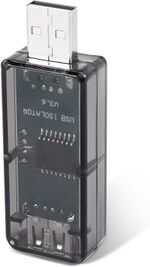Galvanic USB isolator: verschil tussen versies
(→No need for expensive ones) |
|||
| Regel 1: | Regel 1: | ||
[[Bestand:Usb-condom.jpg|150px|USB Galvanic Isolator/Separator]] | [[Bestand:Usb-condom.jpg|150px|USB Galvanic Isolator/Separator]] | ||
| + | [[Bestand:Usb-condom-av.jpg|150px|USB Galvanic Isolator/Separator]] | ||
Most of our nodes are POE powered; but are not galvanically isolated from the LAN (power). | Most of our nodes are POE powered; but are not galvanically isolated from the LAN (power). | ||
Versie van 3 jan 2024 om 13:56
Most of our nodes are POE powered; but are not galvanically isolated from the LAN (power).
It is common (to prevent rust) to run POE at negative voltages; so the 'plus' is somewhat near 0 Volt/earth; and the 'minus' is 40-60Volt below earth. But laptops and other USB devices tend to be wired the other way round.
So it is essential to use a USB condom/galvenic separator when it is connected both to Ethernet and USB.
As otherwise there is a voltage delta of 48 or 2x72V between your devices and earth.
No need for expensive ones
They are relatively expensive; and as they are sometimes mandatory safety equipment when high (kilo) voltages are in use (220V is actually still classed as a low voltage). These easily go vor 150 Euro's and more.
However there is no need for that level of safety in our case; and as it happens - audiofiles worry about a similar issue; in their case the ground loops cause audio quality issues. So using these USB galvanic isolators (which can be had well under 15 euro) is a perfectly good solution.

